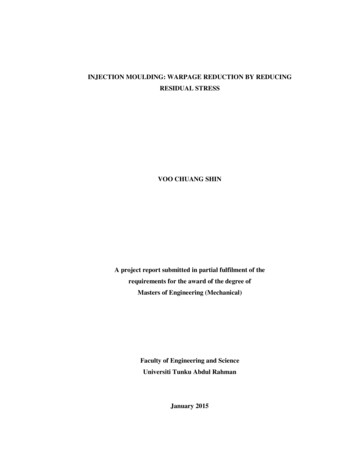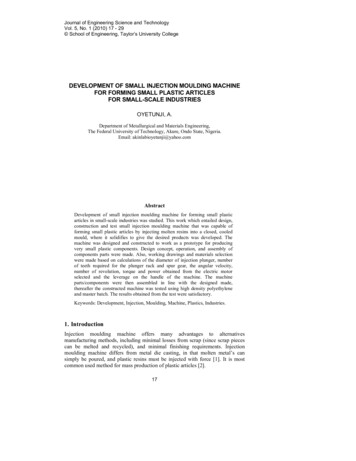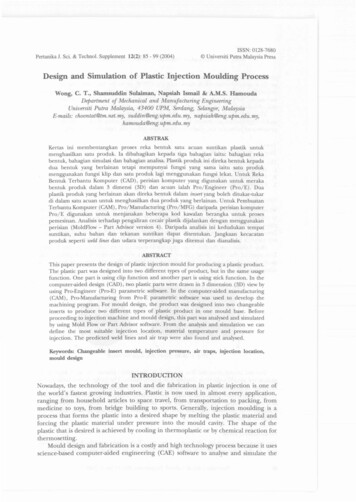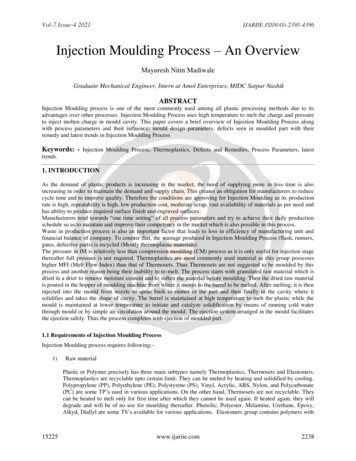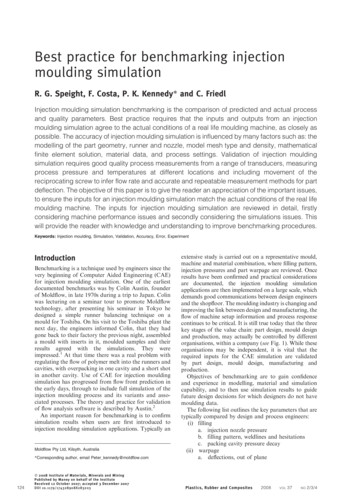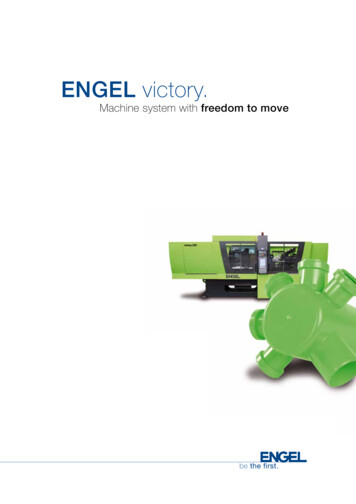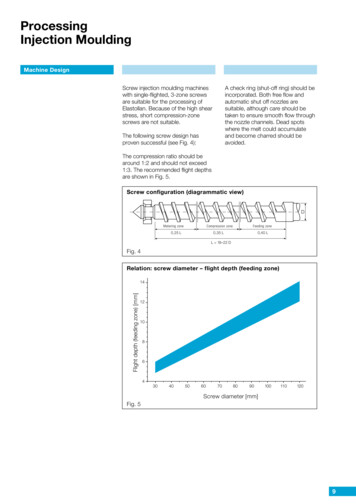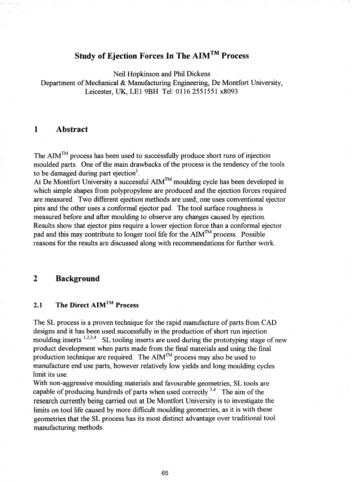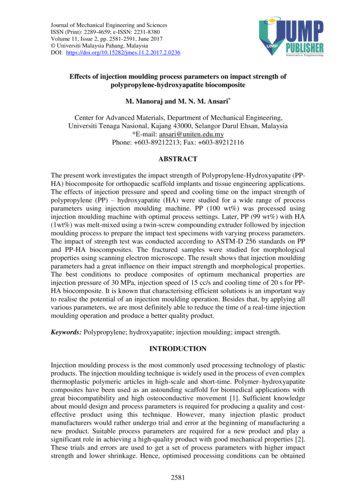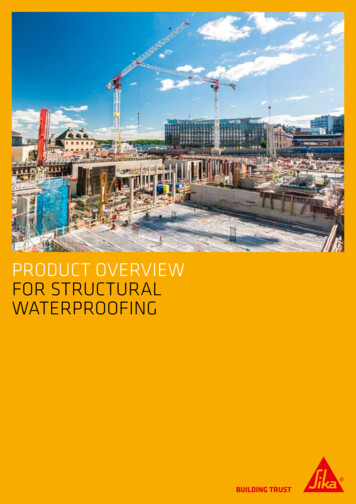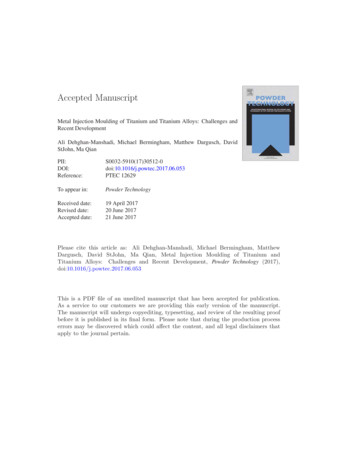
Transcription
Metal Injection Moulding of Titanium and Titanium Alloys: Challenges andRecent DevelopmentAli Dehghan-Manshadi, Michael Bermingham, Matthew Dargusch, DavidStJohn, Ma 1016/j.powtec.2017.06.053PTEC 12629To appear in:Powder TechnologyReceived date:Revised date:Accepted date:19 April 201720 June 201721 June 2017Please cite this article as: Ali Dehghan-Manshadi, Michael Bermingham, MatthewDargusch, David StJohn, Ma Qian, Metal Injection Moulding of Titanium andTitanium Alloys: Challenges and Recent Development, Powder Technology (2017),doi:10.1016/j.powtec.2017.06.053This is a PDF file of an unedited manuscript that has been accepted for publication.As a service to our customers we are providing this early version of the manuscript.The manuscript will undergo copyediting, typesetting, and review of the resulting proofbefore it is published in its final form. Please note that during the production processerrors may be discovered which could affect the content, and all legal disclaimers thatapply to the journal pertain.
ACCEPTED MANUSCRIPTTMetal Injection Moulding of Titanium and TitaniumAlloys: Challenges and Recent DevelopmentIPAli Dehghan-Manshadia*, Michael Berminghama, Matthew Darguscha, David StJohna and MaQiana,b*aSchool of Engineering, Centre for Additive Manufacturing, RMIT University, Melbourne,VIC 3000, AustraliaNUbSCRQueensland Centre for Advanced Materials Processing and Manufacturing (AMPAM)School of Mechanical and Mining Engineering, The University of Queensland, St Lucia,QLD 4072MA*Corresponding Authors: a.dehghanmanshadi@uq.edu.au; ma.qian@rmit.edu.auAbstractDMetal Injection Moulding, MIM, is a well-developed net or near-net shape manufacturingTEtechnique for stainless steel, copper and ceramic materials. This process has receivedincreasing attention over the last decade as a promising technique for the manufacture ofCEPintricate titanium parts for a range of applications in biomedical, aerospace, automotive andother industries. Historically, the necessity to use expensive fine sized spherical ( 45 m),low-oxygen titanium powder has hindered the industrial application of titanium MIM from anACeconomic perspective. However, recent efforts have shown promise in adapting low-costnon-spherical hydride-dehydride (HDH) titanium powder in the MIM process. HDH powderis considerably less expensive than fine spherical powder and thus there is significantpotential in expanding the number of titanium MIM applications. This paper reviews recentdevelopments in MIM of titanium and its alloys as well as the outstanding challenges with aspecial focus on MIM of HDH titanium powder.Keywords: metal injection moulding; titanium; sintering; porosity; density; microstructure.
ACCEPTED MANUSCRIPT1. IntroductionMetal Injection Moulding (MIM) is an established net-shape manufacturing process thatcombines powder metallurgy with plastic injection moulding [1-3]. It combines the mostTuseful characteristics of powder metallurgy (e.g. low cost, simplicity, flexibility ofIPcomposition selection and inexpensive raw materials) and plastic injection moulding (e.g.SCRability to manufacture complex parts and rapid production) to manufacture small-to-mediumsized intricate components and is particularly suited to mass production [4]. The processoffers significant design freedom in shape complexity but most MIM parts are restricted toNUsmaller than about 100 mm in size for high dimensional accuracy and consistency [3, 5].The application of MIM to produce titanium components (MIM-Ti) has been considered for aMAnumber of years [1, 6-11] but progress has been slow. There is essentially no establishedbusiness today due to the need of using expensive fine ( 45 m), low-oxygen spherical Tipowder. Owing to the relatively low density of molten titanium and the high melting point ofDtitanium or liquidus temperature of titanium alloys, the portion of -45 m spherical titaniumTEpowder produced by gas atomisation is low [12]. However, there are other spherical powderproduction techniques such as the plasma wire based atomisation process which offer moreCEPcontrol on purity and powder size [13]. However, in general, the cost of fine ( 45 m), lowoxygen and spherical titanium powder remains excessively high for industrial applications.This is the primary reason for the lack of MIM-Ti business today compared to the establishedACMIM-stainless steel business. The high affinity of titanium for oxygen and carbon requiresspecial considerations during MIM processing (including the requirement for a specialisedbinder system), which can increase the cost of production but this additional cost isinsignificant compared to the cost of the powder.Consequently, from an economic perspective, MIM-Ti parts are not yet competitive enoughwhen compared to similar parts made by machining or casting (e.g. as-cast dental implants).However, as the cost of powders is the greatest barrier to economically manufacturing MIMTi components, using inexpensive titanium powders is expected to improve thecompetitiveness of a MIM-Ti industry. In that regard, the use of low cost hydride-dehydride(HDH) Ti powder has the potential to completely change the situation and has thereforereceived much attention [2, 14-20].
ACCEPTED MANUSCRIPTDespite the issues surrounding the high cost of manufacture, effort has been made to produceMIM-Ti parts for industrial applications. In addition, the first Standards Specification forapplication of MIM-Ti in manufacturing of surgical implants from Ti-6Al-4V and un-alloyedTTi, has recently been published by ASTM [21, 22]. This paper provides an overview of theSCRIPcurrent status of MIM-Ti technology and discusses potential future opportunities.2. The MIM processNUIn a typical MIM process, metallic powders are mixed with polymeric materials (binders) toform a feedstock which can be injection moulded using conventional plastic injectionMAmoulding machines. This fluid feedstock enables the MIM process to be used formanufacturing geometrically complicated components. After the selection of the appropriateDpowder and binder systems, the materials are mixed and kneaded under a protectiveTEatmosphere and at a temperature slightly higher than the melting point of the binder (usuallyin the range of 140-170 C). This forms the feedstock for subsequent injection moulding. TheCEPratio of metal powder to polymer, which is known as “solid loading”, is an important factorfor MIM processing and must be selected so that the mixture has good flowability whilstACminimising the fraction of polymer. The mixing procedure is critically important forsuccessful MIM processing and must ensure that after mixing every individual metal powderis covered by a thin layer of binder to provide enough flowability for processing by injectionmoulding. In this regard, high shear mixers are preferred. In the case of MIM-Ti the entiremixing process should be performed under a protective atmosphere of argon gas to preventany oxygen pickup by the Ti powder. In the next step, the feedstock is granulated into smallpieces 3.0 mm for an easy and smooth injection moulding process. The injection mouldingprocess is usually performed in conventional plastic injection moulding machines. However,some special consideration may be required for the selection of injection dies. For instance,due to the large size of metal powders and the feedstock’s low flowability compared with
ACCEPTED MANUSCRIPTpolymeric materials, a larger injection gating and runner system is recommended for MIM[6]. After injection moulding, the binder needs to be removed from the injection mouldedTcomponents (known as green parts) through two separate steps. During the first step, the mainIPbinder component, which is usually a wax based polymer such as paraffin wax, is removedSCRby a solution debinding process. It is critical that the main binder component is completelyremoved during this stage which ensures a porous part for the easy removal of the secondcomponent during the next step (thermal debinding). An important issue during thermalNUdebinding of Ti feedstock is using a protective environment to prevent any atmosphericMAoxygen and nitrogen contamination in the Ti components. A continuous flow of high purityargon gas is recommended to protect the Ti component and also to flush the decomposedDbinder from the furnace. During the last step the MIM component, which now is a porous partTEpurely containing metal powder slightly bonded together during the thermal debindingprocess (brown part), is sintered at high temperature and under high vacuum to form a solidCEPcomponent. The quality and mechanical properties of the final products are very dependenton the sintering stage and as such a high vacuum (usually better that 10-5 mbar) is required toACminimise oxygen contamination during sintering.3. Critical parameters for MIM-Tia) Powders for MIM-TiAmong all available Ti powders, spherical Ti powder made by gas atomisation (from liquid),plasma atomisation (from wire), or plasma spheroidisation (from non-spherical powder) withan average particle size of 30 m or smaller is ideal for the MIM process due to its goodflowability and the resulting uniform shrinkage during sintering. Fine spherical powder alsoimproves the surface finish of the final sintered products, but as the particle size becomessmaller the impurity content tends to increase (especially oxygen). Coarser powders and/or amixture of coarse and fine powders may be used to increase the solid loading or density of
ACCEPTED MANUSCRIPTgreen parts [2, 23]. Using coarse powders reduces the debinding time, but makes the injectionmoulding process more challenging. With all of these factors in mind, the optimum particlesize for MIM of Ti is considered to be around 45 m [6].THowever, the primary disadvantage associated with such fine spherical Ti powder is its highIPcost. Alternatively, non-spherical Ti powder with higher oxygen contents is readily availableSCRat a fraction of the cost (3-6 times cheaper) of low-oxygen spherical Ti powder. In thisregards, effort has been made to develop viable MIM processes using HDH Ti powders [2, 6,15-19, 23]. One attempt is to use the powdered titanium hydride (TiH2) [15-19, 24], of whichthe de-hydrogenation will occur during thermal debinding and sintering of the MIM parts.NUThe released hydrogen can also help prevent extra oxygen pickup by the final sintered part[6]. For instance, Carren o-Morelli et al. [18] demonstrated the potential of TiH2 powders inMAMIM-Ti by manufacturing components with excellent elongation of 15% and tensile strengthof 666 MPa. In another study, Park et al. [25] used a powder modification process to reducethe sharpness of HDH powders and make them more spherical. This process improved theDtap and apparent density of HDH powders, resulting in an improvement in the solid loadingTEand mould-ability of HDH powders [25]. Using a mixture of HDH and spherical powders isanother alternative to reduce the final cost of MIM parts and also improve the suitability ofCEPHDH powders for MIM processing [2, 23]. German [2] mixed a fraction of small HDHpowder with large gas atomised powders and reported a solid loading of up to 72% (typicalACsolid loading for MIM-Ti is in the range 62-68% for spherical powders).Figure 1 compares the SEM images of three different Ti powders available for MIM process.Gas atomised powder (GA) as the most common powder has spherical shape with goodflowability, consistent shrinkage and smooth surface finish after sintering. Spherical powdersmanufactured through Advanced Plasma Atomization (APA) process offer more control onsize, shape and purity of powders and exhibit exceptional flowability and packing properties[13]. Hydride-dehydride powders have irregular shapes, low packing density, poorflowability, high impurity content and less favourite for any powder metallurgy process.However, their low cost made them an attractive choice for MIM.Figure 1. SEM micrograph of three different Titanium powders a) gas atomised (GA) b)plasma atomised (APA ) and c)Hydride-dehydride (HDH)
ACCEPTED MANUSCRIPTb) Binders for MIM-TiThe selection of a suitable binder that leaves minimum oxygen and carbon residue afterdebinding is a critical step in MIM-Ti. The most important characteristics of a binder includeT[26]:Good adhesion to Ti particles; Low melting temperature for injection moulding; Dimensional stability during debinding; Complete decomposition at low temperature ( 260 C) without any residue afterSCRNUthermal debinding;IP Not chemically reactive with Ti; Provide sufficient green strength and is environmentally friendly;MA As no single binder material can satisfy all of these criteria, thus a mixture of differentcomponents are commonly used as the binder system. Over the years binder systems haveDbeen tailored for MIM of Ti components and are mostly based on well-known binder systemsTEdeveloped for MIM of other materials such as stainless steel [14, 26-33]. In 2012 Wen et al.[26] reviewed most binder systems developed for MIM-Ti, but since then, new binderCEPsystems [28, 30, 34, 35] have been reported. However, a complete and exclusively tailoredbinder system for MIM-Ti is yet to be developed. In addition, specific applications mayrequire special attention to binder selection. For instance, the manufacture of Ti componentsfor biomedical application may require the application of a water-based binder system insteadACof the more common wax-based binders [30, 32, 36]. This is due to the toxicologicalconcerns with organic solvents which need to be used for debinding of wax-based binders.4. Mechanical properties of MIM-Ti and Ti alloysMIM-Ti parts are small and intricate. Most of these parts only require moderate properties,although superior mechanical properties are always desired. Density, interstitial content(oxygen, carbon and nitrogen), microstructure and alloying content can all affect mechanicalproperties and they continue to be the focus of research in order to improve the mechanicalproperties of MIM-Ti.a) DensityOwing to the use of fine powder ( 45 m), a high sintered density (98%) in MIM-Ti parts isreadily achieved when sintered at temperatures 1300 C. Small additions of alloying
ACCEPTED MANUSCRIPTelements such as iron [37-40], nickel [41, 42] or boron [42, 43] can improve the final densityof sintered Ti components. In addition, post-processing may be needed to improve the densityfor specific applications. For instance, where fatigue resistance is important, a shot peeningTprocess has been shown to reduce the surface porosity which improved the fatigue strengthIPby 100MPa [44, 45]. Hot isostatic pressing (HIP) is a common process used to improve thedensity and mechanical properties of MIM and other powder metallurgy components. ThisSCRprocess can substantially improve the ductility of PM parts by closing the remaining porosity.b) Contamination by interstitial elementsOxygen decreases tensile ductility, cold workability, fatigue strength and stress corrosionNUresistance of Ti and its alloys. Figure 2 shows an example of the negative influence of oxygenon elongation and the positive effect on strength of Ti components [7, 46, 47]. Although otherMAinterstitial elements such as nitrogen, carbon and hydrogen could have a detrimentalinfluence on the properties of sintered parts, experience has shown that during MIM theTEDpickup of these elements is negligible in comparison with oxygen [6].Figure 2. Effect of oxygen content on mechanical properties of Ti (adopted from [7])CEPThe predominant sources of oxygen contamination are the initial powder and the sinteringatmosphere but oxygen contamination can also come from the binder, the debinding furnaceas well as the sintering supports (setters) [48]. Therefore, it is important to avoid introducingACextra oxygen contamination during MIM processing, as well as employing methods to reducethe oxygen content of the final products. For example, it is necessary to operate in a highpurity argon environment (more costly) through each MIM process step (mixing, debindingand sintering), and use binder systems containing less carbon and oxygen, appropriate sintersupports (such as Yttria or Zirconia plates) and oxygen scavengers [2, 6, 18, 49-51].Table 1 summarises recent efforts to control oxygen and carbon content during MIM-Ti andits alloys. This table also provides some information on selected powder and binder systemsand indicates how these selections affected the density and mechanical properties of finalproducts. It is clear that using new binder systems, TiH2 powder rather than HDH Ti powder,a reducing atmospheres for debinding and sintering stages as well as developing new Tialloys and mixtures can effectively improve the final properties of MIM-Ti components. Theresults indicate that limiting the oxygen content to less than 0.3wt% for a commercially pure
ACCEPTED MANUSCRIPTTi component or to 0.2% for a Ti-6Al-4V component is possible through accurate selectionTof powder and binder while also controlling the injection, debinding and sintering processes.SCRIPTable 1: A summary of some published data on MIM of Ti and selected Ti-alloys during last20 years [18, 24, 45, 52-69]Prevention of carbon contamination is much easier to achieve than it is for oxygen by using aNUflow of high purity argon cover gas during the debinding process. It is necessary to limit thecarbon content to less than 0.08wt% in order to avoid titanium carbide formation within thestructure [70]. If present, titanium carbides may reduce the elongation and fatigue properties,MAreduce corrosion resistance and enhance the Young’s modules of Ti alloys [70], andaccordingly, their formation should be generally avoided in MIM-Ti components. However,Din some novel studies, the positive behaviour of extra carbon has been exploited in MIM-Ti.Tingskong et al. [71] was able to improve the density of sintered components from 95% inTEpure Ti-6Al-4V to 97.5% with the addition of 1.0% graphite to the Ti-6Al-4V feedstock. Thiscarbon addition also improved all of the mechanical properties of MIM components includingCEPthe yield strength, UTS, elongation and hardness. Such improvement in the mechanicalproperties of MIM-Ti components was attributed to the precipitation of fine TiC particles inACthe microstructure and an extensive refinement of α and -Ti microstructures [71].c) MicrostructureA uniform, fine microstructure, including grain size, lamellar size, phase distribution andmorphology is necessary to improve the mechanical properties of the final products. As ahigh temperature is necessary for sintering of Ti and Ti alloys (usually in the range of 1250 C), microstructure coarsening is expected, although due to using fine powders the graincoarsening in MIM is not as problematic as in other manufacturing processes such as casting.However, controlling the morphology and size of α and lathes and grains is necessary forachieving the desired final mechanical properties and many attempts have been made tocontrol these features. For instance for α structures (such as Ti-6Al-4V) achieving a finelamellar α microstructure is desirable due to its better mechanical properties as seen inFigure 3.
ACCEPTED MANUSCRIPTFigure 3. Dependence of yield strength on inverse square root of a lath thickness forTlamellar (a b) Ti–6Al–4V (adopted from [72-80])IPThere have been many attempts to refine the final microstructure and/or to achieve themicrostructural morphologies suitable for improved mechanical properties (such as fineSCRlamellar structures). The most successful process may be a small addition of grain refiningagents such as boron, LaB6 and TiC to the feedstock [43, 45, 81-83]. Post sintering heattreatments may also improve the ductility and strength of MIM components through theirNUmodification of microstructure. Figure 4 shows examples of general microstructures obtainedin MIM of different Ti alloys. The presence of a coarse microstructure is clear especially forpure Ti (Figure 4a) and Ti-6Al-4V (Figure 4b). Also, Figure 4c illustrates a largeMAimprovement in the microstructure and density of Ti-6Al-4V components by addition ofTED0.5% boron to the feedstock.CEPFigure 4. Microstructure of MIM-Ti samples a) pure Ti with a density of 96.5% [84], b) Ti6Al-4V with a density of 96.4% [44], c) ) Ti-6Al-4V0.5B with a density of 97.7% [45] and d)Ti-16Nb with a density of 95% [60].ACd) AlloyingImprovements to the mechanical properties of Ti components by small (or large) additions ofother elements have always been considered in all manufacturing processes including MIM.Despite using common alloys which have already been developed for other conventionalprocesses (e.g. CP-Ti [15, 17, 55], Ti-6Al-4V [43, 85, 86], Ti-Nb [59-61, 65, 69], Ti-Mo [67,87], Ti-Mn [17, 68], Ti-Ni shape memory [88, 89] and Ti-Al [62] alloys), the addition ofsmall amounts of alloying elements such as B and rare earth elements (Ce, La, Y2O3, etc) aswell as other elements such as Fe, Ni and Zr which add a liquid phase to the sinteringprocess, have been found to have a considerable influence on the final properties of MIMcomponents [43, 90].5. Dimensional accuracy of MIM-Ti components
ACCEPTED MANUSCRIPTDimensional reproducibility, uneven shrinkage and distortion are significant challenges forTi-MIM. These challenges, which are common for MIM of all materials, are more extremefor large-sized parts, which generally limit the part size for MIM to 50mm, wall thickness ofT 5.0mm and weight of 50g. The most important reasons for such dimensional constraint andIPdistortion in MIM components can be divided into three categories [5, 91, 92]:a) Component factors: component size, geometry and wall thickness can significantlySCRinfluence the distortion and dimensional stability of sintered parts. This is becauselarge components carry a greater chance of containing residual binder (despite passingthrough a debinding stage) and are more prone to shrinkage after sintering [5, 93, 94].NUAlso, since long debinding times are required to remove the binders from large andthick sections, oxidation of powders may occur during such long debinding durationsMAwhich can introduce oxides and other defects in MIM parts. This problem is morerisky for Ti (compared with other metal powders such as stainless steel and copper)due to the high affinity of Ti to oxygen and carbon. Furthermore, large andDgeometrically complicated parts can cause non-uniform green density distribution,TEresulting in distortion during debinding and sintering.CEPMaterial composition may also influence component distortion during the MIMprocess. For instance, when phase transformations occur during sintering, thedimensional stability of the component may deteriorate significantly [91] on accountof the sudden volume change in material during transformation, particularly when theACcompact was not fully sintered and the inter-particle bonding is still weak.b) Feedstock factors: powder characteristics such as size, shape and distribution, bindersystems, mixing processes and powder loading can significantly influence distortionand dimensional accuracy of MIM products [2, 5, 92, 95]. For instance, irregularlyshaped particles (such as HDH Ti powders) tend to show more (and uneven)shrinkage compared with spherical powders. Also, coarse powders have been found toshow more distortion compared with fine powders [96].One important source of distortion in MIM components occurs during solutiondebinding on account of swelling of the binder system. As the amount of swellingdepends mainly on the thickness of the specimen, content and type of the binder andsolvent temperature [97-99], components with non-uniform thicknesses may suffermore from swelling resulting on cracks, slumps and distortions.
ACCEPTED MANUSCRIPTc) Processing factors: injection moulding parameters as well as debinding and sinteringparameters can severely influence dimensional accuracy as well as distortion of MIMTsamples. For instance, fast heating rates during debinding and sintering can causeIPsample distortion [91]. Also, surface roughness of the sintering support plate cancause sample distortion [91]. Therefore, extreme care is required to optimise all stepsSCRof the MIM-Ti process in order to control shrinkage and prevent distortion in the finalproducts.NUThe above challenges associated with distortion and shrinkage of MIM-Ti componentsbecome more critical for complex parts. Large components with simple geometries that haveMAflat surfaces to rest on for support during debinding and sintering can be manufactured by theMIM process. However, MIM manufacturing of more complex parts (but with lessrequirement on dimensional accuracy) is still possible using multi surface supports and moreDaccurate selection of resting surfaces as well as a suitable binder system, heating rate andTEsintering temperature. For instance, Miura et al. successfully fabricated a large complex Ti6Al-4V component by careful selection of powder type and size, binder system, heating rateCEPduring debinding as well as the position of supports during debinding and sintering [5, 92].6. Recent developments in MIM-TiACWith a gradual increase in MIM-Ti research, novel techniques and new materials are beingdeveloped for this process. To assess the progress of MIM-Ti research and development, aGoogle patent search was performed to summarize the patents which were filed exclusivelyfor MIM-Ti over the last two decades (Table 2). In this table, the patents mostly deal withnew binders, new feedstock materials and new manufacturing methods for specificcomponents (especially for biomedical applications). Figure 5 summarizes the number ofMIM-Ti related patents filed in each year taken from Table 2. Overall, the number of patentsfiled each year is limited to just a few, indicative of insufficient business opportunities andresearch development in MIM-Ti.
ACCEPTED MANUSCRIPTFigure 5. The number of MIM-Ti related patents filled from 1990 (data collected fromTGoogle Patent search)SCRfor MIM-TiIPTable 2. A summary of patents filed during recent decades exclusively or more significantly NUHighlighted below are a few novel developments selected from the patents listed in Table 2.Patent JP2005281736 disclosed a new solution for low cost manufacturing of MIM-TiMAalloy components with high mechanical properties and low oxygen content. Theymixed different fractions of TiH2, HDH titanium and 60Al-40V pre-alloyed powdersto manufacture Ti-6Al-4V components with low oxygen and excellent mechanicalDproperties. Optimum mechanical properties of YS 910 MPa, UTS 950 MPa andTEEl 14% were obtained by mixing 25 wt% TiH2 and 75 wt% HDH powders. Theresulting relative density is 97% and oxygen level is 0.31%. Contrary to other reportsCEP[16], they observed that increasing the TiH2 fraction in the powder mixture increasesthe oxygen content, which resulted in a decrease in elongation. A new binder system was reported in patent US7883662B2 for the control of theACoxygen and carbon content in MIM-Ti components. Using an aromatic binder systemincluding naphthalene, polystyrene and stearic acid, the oxygen and carbon level inthe final Ti-6Al-4V sintered parts remained at very low levels of 0.197wt% and0.05wt% respectively, which is in the accepted range by ASTM F2885 standard forMIM-Ti surgical tools. Patent CN105382261 described a novel technique to improve the dimensionalaccuracy of MIM-Ti components. The inventors mixed titanium powders withdifferent average particle sizes to produce MIM feedstock and found the optimummixture for best dimensional accuracy. For instance, using three powders withaverage sizes of 46.8 m, 34.5 m and 24.4 m and ratios of 68:24:8 percent, theyobtained a high dimensional precision of 1%, uniform structure, low oxygen level of 0.25wt% and high mechanical properties.
ACCEPTED MANUSCRIPT Patent CN103266319 developed a new technique based on the insert molding andMIM-Ti processes to cover the surface of cast Ti implants by a thin and porous layerto improve the biocompatibity and reduce the Young modulus of the implants. ForTinstance, using TiH2 powders with average particle size of 40 m and oxygen contentIPof 0.3wt%, the inventors created a porous coated surface with oxygen content of0.32wt%, porosity of 60% and bonding strength of 420MPa. The density and bondingSCRstrength of the coated parts can be manipulated by changing the Ti powder shape,particle size, binder system and sintering conditions.To better evaluate the most recent developments on MIM for Ti and its alloys, a selection ofNUindustrially important Ti alloys are discussed in following sections.MAa) Commercially Pure (CP) TiCommercially pure titanium (CP-Ti) has received the most research and development workon MIM practice. Despite the common industrial application of CP-Ti, another reason for thepopularity of CP-Ti in MIM practice is related to the greater acceptable tolerance for oxygenDcontent, which can be up to 0.4% for grade 4 (in comparison the acceptable oxygen limit forTETi-6Al-4V is only 0.2%). Frequent research and industrial scale work on MIM of CP-Tiindicate that this process is able to manufacture components with chemical composition asCEPwell as mechanical properties in the accepted range by ASTM standards. For example, usingplasma atomised spherical powders with an oxygen level of 0.14%, Sidambe et al [55]manufactured Ti components through the MIM process with final oxygen content, elongationACand tensile strength of 0.2wt%, 20% and 470MPa, respectively. All of these values fulfil therequirements of ASTM standard for CP titanium grade 2, which is an excellent achievementfor the MIM process. However as mentioned previously, the high cost of spherical powderswith low oxygen level is a major barrier for MIM of CP-Ti. In this regards many att
mixing process should be performed under a protective atmosphere of argon gas to prevent any oxygen pickup by the Ti powder. In the next step, the feedstock is granulated into small pieces 3.0 mm for an easy and smooth injection moulding process. The injection moulding process is usually performed in con
